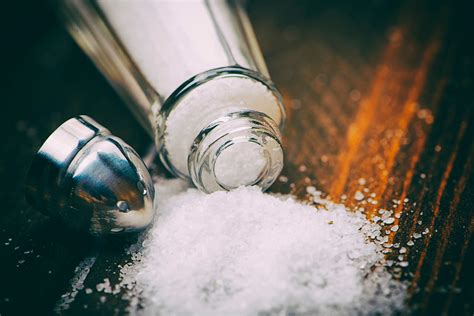Introduction
Salt, an indispensable seasoning and preservative in kitchens worldwide, is composed primarily of sodium chloride (NaCl), a crystalline compound with a captivating chemical composition. Delving into the chemistry of table salt reveals a wealth of unexpected applications and significant implications in various scientific disciplines.

Chemical Structure and Properties
Sodium chloride crystallizes in a cubic lattice structure, where each sodium ion (Na+) is surrounded by six chloride ions (Cl-), and vice versa. This orderly arrangement gives salt its characteristic white color and cubic crystal shape.
NaCl’s high solubility in water (359 g/100 mL at 25°C) allows it to readily dissolve and form ions, contributing to its ability to enhance flavors and act as a preservative. Its strong ionic bond (495 kJ/mol) ensures salt’s stability at room temperature.
Key Properties of Sodium Chloride:
| Property | Value |
|---|---|
| Molecular Weight | 58.44 g/mol |
| Melting Point | 801°C |
| Boiling Point | 1413°C |
| Solubility in Water | 359 g/100 mL at 25°C |
Applications in Food Preservation
Salt’s antimicrobial properties make it an effective preservative for food. It inhibits bacterial growth by drawing water out of microbial cells through osmosis, causing dehydration and cell death. This process, known as salting, has been used for centuries to preserve meat, fish, and vegetables.
The World Health Organization (WHO) recommends a daily salt intake of less than 5 grams to reduce the risk of hypertension and cardiovascular disease. However, excessive salt consumption can lead to health concerns such as high blood pressure, stroke, and kidney disease.
Industrial Applications
Beyond food preservation, salt finds widespread use in various industries. It is employed as a deicing agent on roads and sidewalks during winter to prevent ice formation, a practice that consumes approximately 15 million tons of salt annually in the United States.
In the chemical industry, salt serves as a starting material for the production of chlorine, caustic soda, and hydrochloric acid. It also plays a vital role in the manufacture of paper, textile dyes, and fertilizers.
Table of NaCl Applications:
| Industry | Application |
|---|---|
| Food | Preservative, Flavor Enhancer |
| Pharmaceuticals | Active Ingredient, Tablet Excipient |
| Textiles | Dyeing Mordant |
| Road Safety | Deicing Agent |
| Chemical | Raw Material for Chlorine, NaOH, HCl |
Electrochemistry and Salt Bridge
Sodium chloride solutions have high electrical conductivity because of the dissociation of ions in water. This property makes salt an electrolyte, capable of conducting electricity.
In electrochemistry, a salt bridge is a device used to connect two electrochemical cells and allow the migration of ions. Salt bridges maintain electrical neutrality in the system while preventing mixing of solutions.
Environmental Implications
Salt is naturally abundant in the environment, but human activities such as mining and agricultural runoff can lead to increased salt concentrations in water bodies and soils. High salt levels can adversely affect aquatic organisms, disrupt plant growth, and contaminate drinking water.
The Environmental Protection Agency (EPA) sets limits on salt concentrations in water to protect aquatic life and prevent ecological damage.
Common Mistakes to Avoid
1. Excessive Salt Consumption: Consuming more than the recommended daily limit of salt can pose health risks. Monitor salt intake and limit processed foods to avoid overconsumption.
2. Salting Food Before Cooking: Premature salting can draw moisture out of meat and vegetables, resulting in dry and tough textures. Salt food towards the end of cooking to enhance flavors without compromising texture.
3. Using Salt as a Nutrient: Salt does not contain significant nutritional value and should not be used as a substitute for essential vitamins and minerals.
Step-by-Step Approach to Understanding Table Salt Chemistry
1. Identify Properties: Learn the chemical structure, properties, and solubility of NaCl.
2. Explore Applications: Understand the role of salt in food preservation, industrial processes, and electrochemistry.
3. Grasp Environmental Impact: Recognize the potential environmental implications of salt and its responsible use.
4. Apply in Experiments: Conduct simple experiments to demonstrate salt’s conductivity, solubility, and use as a preservative.
Why Table Salt Chemistry Matters
The chemistry of table salt has a profound impact on various aspects of our lives:
Health: Understanding salt’s effects on blood pressure and cardiovascular health is crucial for dietary guidelines and disease prevention.
Industry: Salt’s versatility contributes to the production of essential chemicals, textiles, and other products.
Environment: Managing salt concentrations in water bodies and soils is vital for protecting ecosystems and preserving water quality.
Novel Applications
The science of table salt continues to inspire innovative applications:
Electrolytes for Batteries: Researchers are developing salt-based electrolytes for high-performance batteries with improved safety and energy density.
Antimicrobial Coatings: Salt-infused coatings can inhibit bacterial growth on medical devices, reducing the risk of infections.
Saline Irrigation: Using salt solutions to irrigate crops can enhance drought resistance and improve soil fertility in saline environments.
Conclusion
The chemistry of table salt extends far beyond its culinary uses. Its unique properties and diverse applications have significant implications in food preservation, industry, electrochemistry, and environmental science. By understanding the intricate nature of salt, we can harness its versatility for the benefit of society and the environment.
